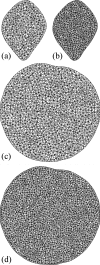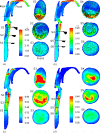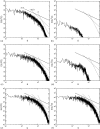On intra- and intersubject variabilities of airflow in the human lungs
- PMID: 19901999
- PMCID: PMC2774343
- DOI: 10.1063/1.3247170
On intra- and intersubject variabilities of airflow in the human lungs
Abstract
The effects of intra- and intersubject variabilities in airway geometry on airflow in the human lungs are investigated by large eddy simulation. The airway models of two human subjects consisting of extra- and intrathoracic airways are reconstructed from CT images. For intrasubject study, airflows at two inspiratory flow rates are simulated on the airway geometries of the same subject with four different levels of truncation. These airway models are the original complete geometry and three geometries obtained by truncating the original one at the subglottis, the supraglottis, and the laryngopharynx, respectively. A comparison of the airflows in the complete geometry model shows that the characteristics of the turbulent laryngeal jet in the trachea are similar regardless of Reynolds number in terms of mean velocities, turbulence statistics, coherent structures, and pressure distribution. The truncated airway models, however, do not produce the similar flow structures observed in the complete geometry. An improved inlet boundary condition is then proposed for the airway model truncated at the laryngopharynx to improve the accuracy of solution. The new boundary condition significantly improves the mean flow. The spectral analysis shows that turbulent characteristics are captured downstream away from the glottis. For intersubject study, although the overall flow characteristics are similar, two morphological factors are found to significantly affect the flows between subjects. These are the constriction ratio of the glottis with respect to the trachea and the curvature and shape of the airways.
Figures




















References
-
- Weibel E. R., Morphometry of the Human Lung (Academic, New York, 1963).
-
- Horsfield K., Dart G., Olson D. E., Filley G. F., and Cumming G., “Models of the human bronchial tree,” J. Appl. Physiol. JAPHEV 31, 207 (1971). - PubMed
-
- Comer J. K., Kleinstreuer C., and Zhang Z., “Flow structures and particle deposition patterns in double-bifurcation airway models: Part 1. Airflow fields,” J. Fluid Mech. JFLSA7 435, 25 (2001).
-
- Comer J. K., Kleinstreuer C., and Zhang Z., “Flow structures and particle deposition patterns in double-bifurcation airway models: Part 2. Aerosol transport and deposition,” J. Fluid Mech. JFLSA7 435, 55 (2001).
Grants and funding
LinkOut - more resources
Full Text Sources
